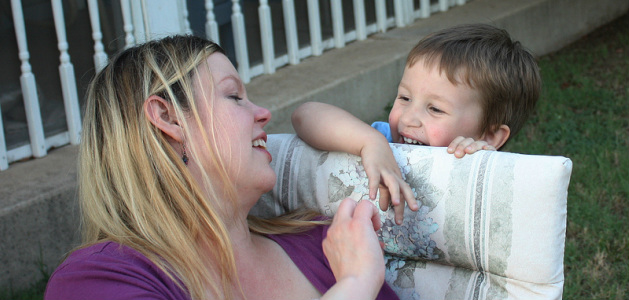|
Remember the old adage, “Silence is golden”? As parents, we have a hard time with this notion. We believe that when a child makes a statement, he is implicitly asking for a response. And, of course, we oblige, thinking that communication with our child is important. But here’s a new notion for you: You don’t have to respond to every comment that comes out of your child’s mouth. Sometimes the most effective form of communication is keeping silent. There are times when it’s okay for your child to have the first, the last, and the only word. This is especially true for those times kids come up with “announcements” that sound remarkably like complaints, perhaps even remarks that unfairly blame you. Typically parents respond to these comments by suggesting, clarifying, or simply disagreeing. But these seemingly innocent comebacks have the potential to ignite a power struggle since they unwittingly challenge the kids to make their own point even more strongly. Instead of chiming in, simply listen. Show you’re paying attention, but don’t feel compelled to comment when it’s not necessary. Remember, silence is often a valuable communication skill. … Silence is [one] way to acknowledge your child’s problem without becoming part of it. You are not being hostile or rejecting; at the same time, you’re not setting yourself up to be the fall guy for your child’s anger. Believe it or not, most of the time kids say things to get them off their chests and they really don’t expect you to do anything. Remember those easy-to-forget, undervalued words “Oh,” “Hmm,” “Really”—those short lifesavers that keep you out of a fight. These overlooked words are just as versatile as they are short. You can use them in many ways. The secret is in your tone of voice and how you punctuate your line. You may want to punctuate it with a heavy period, meaning “That is the end of this discussion”; an exclamation mark, meaning “Your comment has made an impression on me”; or even a question mark, meaning “I really do want more information.” When you use the “silence is golden” and “keep it short and simple” skills, you can: — stop a battle before it begins. — acknowledge to your child that you’ve heard him. — keep yourself from becoming defensive. — avoid getting caught up in an issue that you have no intention of solving.--Evonne Weinhaus and Karen Friedman * The importance of developing our listening ability is directly affirmed by James, a man who knew Jesus intimately: “Let every man be quick to hear, slow to speak.” (James 1:19) The two terse commands contained in the beginning of this verse fit nicely together. When we take time to listen responsively—and avoid the error of answering with authoritative pronouncements—the messages given back to us by our children are far less likely to be obnoxiously defensive. This, in turn, reduces the tension and may well help us avoid angry exchanges.--Dr. Bob Pedrick * Hear from Me about your children. This is a gift I could bestow upon you to make your job of parenting easier. It is a gift certificate which never expires, has no cash limit, and is redeemable anywhere, at any time. I can show you the reasons your children are behaving the way they are, their motives, the root of the problem, and the solution. I can give you the words to say that will help and inspire them. I can point out the good things that you can commend them for, and show you what the weaknesses are that you need to work with them on next. I can comfort and encourage you when you are weary and discouraged, and give you patience and faith when you are in need.--Jesus, speaking in prophecy * Children will behave more responsibly and maturely if they are talked to with the same respect you would give an adult. If a child feels that you expect him to behave in a responsible way, then he’ll more than likely try to fulfill your expectations. We should try as much as possible to put ourselves in our children’s place and communicate with them in the way that we would like to be communicated with if we were them.--Maria Fontaine * How would you feel if someone who was [in a position of authority over you] got angry and screamed at you? You’d probably feel like shriveling up and blowing away. Add an audience, and you’d feel verbally tarred and feathered. Now, you might quickly do what that authority figure wanted you to do, but you’d despise that person for embarrassing you. Children aren’t that much different from grown-ups in this respect. They don’t like being belittled or demeaned, especially in front of an audience. It would be best if you could catch yourself before you got so upset that you felt like screaming. Here are some ideas: If your child isn’t paying attention the first or second time you speak, try lowering your voice instead of raising it. Go over to your child, look him in the eyes and whisper your message. Or you might want to go one step further and try the silent method. Just go and stand next to your child and don’t say anything until he or she turns and looks at you. When you have her full attention, make your request. Sometimes just placing your hand softly against the child’s back and waiting will get her attention. Once you have your child’s attention, make your request clearly and firmly. Then make sure you follow up so you are certain she is doing what you want. When you do this, you’ll find a significant increase in your child’s compliance without any harmful side effects. And, you’ll feel a whole lot better by having tempered your temper!--Dr. Kay Kuzma * Do you ever sit down with your child and talk for a few minutes only about his or her concerns? Finding a few minutes each day to do this will pay handsome dividends in building a relationship of loving trust with your child. What will you talk about? What is your child concerned about most? People who are good conversationalists will tell you that you can talk for hours with anyone of any age, at any intellectual level, adult or child, and hold them captivated. All you have to do is show a genuine interest in that person and ask questions that help you explore that interest. What does this person do? How does he do it? What does she like? Why? If you want people to show loving concern for your interests, think how much more your child wants you, as a parent, the most important person in the world to him, to show that loving concern for his interests. But exactly what should you say when you take those few precious moments to talk with your child? That depends on what your child has done. Did he just come home from school? Is it time to read her a bedtime story? Did he just break a favorite dish? Is she having a temper tantrum? Is he sassing you back about something? Did she just come through the door crying because some friends weren’t being kind to her? Start with the circumstance. That’s always a good starting point, because that is uppermost in the child’s mind at that time. Then go from there.--V. Gilbert Beers Courtesy of http://anchor.tfionline.com/post/hidden-art-communicating-children/. Photo by dadblunders/Flickr.com
0 Comments
Maria Fontaine On a flight I took some months ago, there was a little girl sitting in the catty-cornered seat from me. She had a beautiful new coloring book that her mother had obviously brought especially for the flight. Occupying the same row was another girl about the same age whose father was seated behind her. This girl had no coloring book, and in fact, didn’t seem to have anything to occupy her. The girl with the coloring book was soon busily coloring with her crayons spread out on the tray table, and the other girl was looking longingly at them. I felt bad for the girl who had none, so I prayed that the first child would feel moved to tear out a page from her nice coloring book and share it. Sure enough, after a while I saw that she had indeed torn a page out and had given it to her seatmate and was sharing her crayons with her. I leaned forward across the aisle and told the girl that sharing her coloring book was such a nice thing to do. She brightened up and was obviously pleased that someone had noticed. I don’t know how far that little exchange will go, but I would like to think that the next time she has to make a choice whether to share something or not, she will be reminded of the woman who was proud of her because she made the right decision. Here’s a question we can ask ourselves: What can I say to my children that will help them in some way?—Lift their spirits, brighten their day, and make them feel good about themselves, appreciated, valued and, worthwhile? Even brief encounters with our children lend themselves to “a word fitly spoken” (Proverbs 25:11), something that will give them faith in themselves. Adapted from article originally published in Activated magazine.
We can change the world by improving the lives of those around us, through deeds of kindness and consideration, and by showing faith in them. Here are some practical tips to help get you started changing your part of the world, one heart at a time. Build up excellence. Try to think of at least one thing that you find outstanding in your child, and then make it your task to let them know. Don’t be shy; they won’t get tired of hearing it. What you’re doing is building confidence in that one area, and as they gain confidence, they will start to improve in other areas as well. Share the responsibility. Give your children responsibility in the areas in which they are strong. Make them feel trusted, needed, and appreciated. Appreciate who they are. Appreciating your children for what they do is important, and children like to be thanked and acknowledged for it, but being appreciated for a personal trait feels a lot nicer than only being appreciated for the outcome of that trait. Slow down. It takes time to see people in a new light. Go slower in your interactions with your child and give God a chance to reveal His perspective. Let go of the past. Everyone dislikes being labeled or put in a box. Be willing to see who your child is today or the potential of what they can be tomorrow. Adapted from article in Activated magazine. Marianne Neifert, M.D My life has been devoted to children and families—my own, and those I’ve encountered in my career as a pediatrician. My first baby was born only a few months before I started medical school, and my fifth child arrived seven years later, on the final day of my pediatric residency. These two paths—medicine and motherhood—have been inextricably intertwined; they’ve often enhanced—and sometimes competed with—one another. But over the years, as I’ve helped my own children journey into young adulthood and worked with countless families in my career, I’ve gained some hard-earned perspective and insights into raising kids. No parent will have all the answers all of the time, but these simple parenting guidelines can help make your time together as a family that much richer. Provide unconditional love and encouragement As her parent, you’re the first one to convince a child of her worth and help her venture into the world with confidence. You can make her feel cherished by giving her your time and attention daily, whether by reading a book, playing, or talking together. For instance, try to spend a little one-on-one time with your child when you get home, before you do anything else. After picking her toddler up at daycare, one mom I know uses the walk home as a way to reconnect. If she runs into friends, she’ll wave at them but won’t stop to chat; she’s learned that it frustrates her daughter too much. Show your child that you value her by acknowledging her feelings, and by listening when she talks. It’s easy to let your mind wander as a toddler or preschooler babbles on, but kids are very good at picking up on when you’re distracted. Having a focused conversation with your child—rather than just responding with the occasional “Uh-huh”—builds up her vocabulary at the same time that it boosts her self-esteem. The way you encourage your child is also important. By emphasizing her efforts (“You sure seemed to enjoy working on this picture for Grandma”) over her results (“I like the way you stayed inside the lines this time”), you’ll show support and foster self-approval, and make her less reliant on the acceptance of others. And finally, the best way to encourage your child? Simply tell her that you love her as often as you can. Make your child your highest priority We all face enormous demands on our time, and our family life is always threatened by competing priorities, whether or not we work outside the home. But we have to learn to distinguish the important things, like spending time with our youngsters, from the urgent things, like ever-present project deadlines and chores. The truth is that in order to be an effective parent, you have to continually re-rank your priorities. When I had my first four babies during college, medical school, and my internship, I breastfed each one. But I didn’t make it to the one-year mark, the ideal goal. It wasn’t until I made a conscious decision while I was pregnant with my fifth baby to put breastfeeding higher than other priorities that I succeeded. To do that, I had to say no to several opportunities—including taking over a busy practice—at the end of my residency training. Putting your kids first doesn’t mean you have to be a martyr, or a superwoman. No one is saying that you can’t take time for yourself. But it does mean that sometimes you have to make choices. A hospital administrator I knew gave up her job to accept a less prestigious position so she could spend more time with her daughter. The turning point came as soon as her daughter’s preschool teacher told her, “Whenever Kaitlyn draws a family picture, you’re not in it.” Strengthen your team Generally speaking, moms act as the principal caretakers of immediate physical and emotional needs. Dads, on the other hand, tend to promote risk-taking and independence, and build self-reliance and assertiveness because they are more apt to let kids work out their problems by themselves. Each of these responses—the security of knowing you have a nurturing home base and the space to figure out what you need—communicates an important message to your child and gives him the ability to handle whatever life throws at him. Thanks to my husband, my daughter Tricie learned to swim during one of our family vacations when she was 4. While he was busy encouraging her to go down the pool’s water slide, I was busy admonishing her to be careful. The best way to start operating like a team is to agree with your partner on the big things—like what rules you’ll have and how to discipline—and then let each of you handle the day-to-day routines as you see fit. Moms, especially, must let go of the feeling that they know what’s best for their children. Otherwise, dads will always be consigned to the helper role. What about single parents? Do everything you can to cultivate meaningful relationships with other loving adults, whether relatives or trusted role models, like teachers and scout leaders. And, as hard as it may be sometimes, it’s important for divorced parents to work together with an ex-spouse so their child doesn’t feel like he has to choose between them. If your ex is out of the picture or unable to give emotional support, be honest about the circumstances, and help your child work through his grief. Discipline consistently The best way to help teach your child to distinguish right from wrong is by setting clear limits and enforcing them consistently. If you feel as though you’re slipping into a power struggle, step back: Give your child a time-out or simply tell her you’ll deal with her in a few minutes—and don’t decide on a punishment until you’re more calm. When she does break the rules, respond in a way that won’t deal a blow to her self-esteem: Ignore attention-getters like whining; give a brief warning or scolding for minor infractions (such as jumping on the furniture); issue an age-appropriate time-out to stop aggressive or antisocial behavior (like biting and hitting); and use logical consequences, such as putting their toys aside for a day whenever your kids fight over them. But discipline isn’t just a question of punishment. It’s also about modeling positive behavior—like remembering to say “please” and “thank you” to teach your child the value of manners—and praising her when she’s been cooperative and helpful. By spending extra time with your child, you can minimize whining and other misbehaviors triggered by a need for attention. Teach responsibility One of the best gifts you can give your child is to help him understand that he’s responsible for the choices he makes as well as the consequences of his actions, and ultimately, his own happiness. The first step toward building self-reliance: Offer your child choices that are right for his age. Toddlers are capable of picking what they want for breakfast or which shirt to wear (as long as you give them two choices). A three-year-old can also pitch in and do simple chores—helping you pick up toys or unload the dishwasher, for instance. Delegating these tasks not only lets your preschooler make a contribution to your household, but teaches him accountability. The next step: Encourage your child to tackle new skills, like riding a trike or reading a story aloud. If he makes mistakes, let him work through them instead of rushing in to fix things. You’ll promote a sense of competence, and he’ll learn to weigh consequences before acting. When he faces inevitable setbacks and failures, help him discover how to look for solutions rather than view such obstacles as beyond his control. If your toddler cries when another child takes his toy, for example, say, “Let’s go see if she’ll give it back.” Or if your preschooler tells you he has no friends, you can show him, through role-playing, ways to ask other kids to play, or together invite someone to come visit. Lastly, encourage your child to think, even if his opinions differ from your own. You’ll free him from a fear of disapproval that will make him less dependent on others for his happiness. Use routines to create a sense of togetherness Family rituals and familiar patterns provide kids with a sense of security. Little children are reassured by knowing that their morning outing—whether to the park or the library—is followed by lunch, or that naptime will come after story time. School-age kids also look forward to predictable shared events, such as eating dinner together or spending time with Dad on weekends. These routines increase your child’s perception of control, which in turn increases her confidence. Traditions also provide the social glue that bonds one generation to another, creating many of the special “anchor” memories within a family. In my own case, I hosted a multigenerational Thanksgiving reunion for years that gave our children both a strong family identity and sense of connection to their past. Take time to recharge You know the adage: “If Momma ain’t happy, ain’t nobody happy.” Chronic sleep deprivation, isolation, and self-neglect can leave a parent physically depleted, emotionally discouraged, and, ultimately, ineffective. So give yourself permission to take a break—to renew your perspective, enthusiasm, sense of humor, and energy. That may mean an afternoon off to visit a friend or go to a movie. Or it may be as simple as learning to ask for what you need, and accepting help from others. I once met a woman who had lost her mother, but whose mother-in-law had become like a second mom to her. She explained that the older woman had helped her raise her children and preserved her marriage. “I never could have done it without her support,” the woman insisted. Her mother-in-law just smiled and modestly acknowledged, “Everybody needs somebody to steady things up.” “That’s it!” I thought, as a virtual parade of helpers flashed through my mind—individuals who had steadied things up for my husband, Larry, and me when we were overwhelmed with responsibility for five children. In fact, we were aided every step of the way by the experience and generosity of grandparents, aunts and uncles, babysitters, teachers, coaches, pastors, neighbors, and friends. On many occasions, Larry and I enjoyed a night out, and even a weekend getaway, because we had asked someone, and someone had agreed to stay with our kids. And we were then better able to take care of our children because we had taken care of ourselves. Marianne Neifert, M.D. is the author of three books, most recently Dr. Mom’s Guide to Breastfeeding. Article from http://living.msn.com/family-parenting/parenting-tips/article?_skipscp=true&cp-documentid=31973647. Photo copyright (c) 123RF Stock Photos Dr. Kay Kuzma Being a good listener is a simple way to show you understand and care. Here are some guidelines to follow: 1. Show interest in your child’s conversation. Look up. Make appropriate comments. Stop what you are doing. 2. Don’t correct his speech while he is talking to you. 3. Focus on the hidden message—if you think there might be one. 4. Don’t contradict his story or the points he is making until he has finished and wants your opinions. 5. Don’t squelch a child when he voices offbeat values or comes to an impossible conclusion. Don’t laugh, make fun of, belittle, tear down, or in any other way make it more difficult for a child to open up his heart and ideas to you in the future. 6. Be an active listener. Active listening means active involvement with the person who is communicating. To show that you are actively listening, make little expressions of understanding, such as, “Yes,” “Aha,” “I see,” etc. 7. Encourage your child to talk, to express himself, and to share his values and goals. One way to encourage your child to share his world with you is to have a “talk about it” bowl or basket that sits on the kitchen table. During the day, the children can put objects, notes, newspaper clippings, or articles into the bowl that they would like to talk about during dinner. Write a variety of questions on paper placemats. …Choose questions that will stimulate a good conversation. When the dinner conversation seems to drag, read off a question, like, “What would you do if you just inherited a million dollars?” Or, “If you knew you were going to die in one month, how would you spend your time?” 8. Children should be encouraged to communicate on the feeling level. If children are going to learn to communicate their feelings, then you must encourage them to do so. Does your child know that it is safe to say, “Mommy, I feel sad. Hold me a little bit.” “Mom, I feel discouraged. Do you have a minute to talk?” “Dad, I got angry when you spoke to me like that. Can we discuss it?” What kind of communicator are you? For one hour while your whole family is together, record your conversation. Then analyze your interactions. Excerpted from the book "Prime-Time Parenting" by Dr. Kay Kuzma.
Lois and Joel Davitz Learn to substitute some other behavior for nagging whenever you get the impulse to nag. Parents can use a wide variety of substitutes when the impulse to nag occurs. One parent decided to say something complimentary to her son whenever she felt like nagging him. At first her substitute compliments seemed forced and artificial to both her son and herself, but they realized that she was sincerely trying to break a long-established habit, and they accepted this initial awkwardness. After awhile, the substitute behavior became more and more natural, and the frequency of her nagging decreased dramatically. Parents who go through this process of stopping their nagging almost always report certain positive consequences. Perhaps the most important and the most rewarding consequence is the decrease in family stress. The number of arguments drops sharply, and both parents and their [children] have a chance to learn how to live together without the irritation of petty bickering. An interesting result we have noticed on a number of occasions is a change in the [child’s] behavior that had been the focus of nagging. The [child], for example, who has been nagged about not doing homework begins to do the work after the parents stop nagging about it. This suggests that sometimes nagging actually provokes the undesired behavior. All parents dislike nagging their children. However, it is sometimes difficult to find a reasonable alternative that will propel children to do what needs to be done. Here are some tips for getting action out of your communications with your children.
Excerpted from the book, "How to Live (Almost) Happily with a Teenager". Image courtesy of David Castillo Dominici at FreeDigitalPhotos.net
By Jessica Roberts In the middle of math class, one of my second graders made this startling declaration: “There is no God!” Considering that this was a Christian school and Martin was the son of a pastor, I had to wonder how he had suddenly come to this conclusion in my classroom. When asked, he proclaimed, “My dad says that there’s God, Jesus, and the Holy Spirit, but also that there’s only one God. It makes no sense.” What to do? I was sure that greater minds than Martin’s had contemplated the Holy Trinity and run into the same problem, but at the moment I really preferred to stick to multiplication. “Martin, we’re in math class. We can talk about that later.” “It is a math problem,” Martin replied. “Three is not the same as one!” What parent or teacher hasn’t been similarly ambushed? From the lips of children come a lot of tough questions. I’ve learned that the best thing I can do in such cases is ask God for wisdom, because what I may interpret as cockiness or contrariness on the part of the child may in fact be divinely instilled inquisitiveness and a great teaching opportunity. I didn’t feel sufficiently brushed up on my theology to explain the concept of the Trinity to Martin and his classmates. … Recess. Saved by the bell! For the next ten minutes, while the children played, I prayed. And an answer came to me. It was a bit simplistic and probably not how St. Augustine or other Christian thinkers would have explained it, but it worked for Martin and the others when math class resumed. “The Bible calls Jesus the Rose of Sharon,” I told them. “God is like the root of the rose bush. He’s hidden, but that’s where the rose had its beginning and grew from. Jesus is like the rose blossom. He is the showy part of God’s love that we can ‘see’ and sense. The Holy Spirit is like the sap that flows through the bush, keeping it alive. Three aspects, but the same rose bush. See?” I imagine Martin will have even tougher questions in the future, and of course I have plenty of questions myself. Thankfully, God always answers when we ask sincerely. He may give a simple, straightforward explanation like the one He gave for Martin, or one that’s more involved, or He may simply give us peace to accept what we cannot yet understand. Courtesy of Activated magazine. Used with permission.
New parents take one long, deep look into the eyes of their baby and vow to never hurt or disappoint the child. Why then do parents nag, belittle, and get impatient? Familiarity often breeds contempt. As time passes, we become familiar with the people we are closest to, and we stop valuing and treating them like we should. The wear and tear of daily living takes its toll, and the bright newness of once-treasured relationships begins to fade. Up close and personal, everyone’s flaws and wrinkles begin to show. Routines become ruts. Our once-prized blessings begin to weigh on us. Sound familiar? Then it’s time to reverse the trend. That will take a conscious effort and may not be easy, especially if the problem has been going on for some time, but it can be done. Count your blessings. The quickest and surest way to return the shine to any tarnished relationship is to polish your half. Get busy being the person you set out to be at the start, and the other party will almost certainly follow suit without direct prompting. * Motivators, therapists, and child psychologists have discovered that praise makes us stretch ourselves. In the warm glow of knowing we have pleased another, we try harder to please. Hearing that we have done well, we want to do better. —Shannon Shayler * Praise is to children what water is to flowers. Pour it on and watch them grow. —Shannon Shayler * Everyone has good qualities. Find specific things about your children that you can sincerely compliment them on, and be generous with your praise. If you can’t find anything right off, look deeper. The harder it is to find that special “gold,” the greater the reward is likely to be for both of you when you do. If you can find even a threadlike vein and shine a little love on it in the form of praise, it will lead you straight to the mother lode. They’ll open up to you, and you’ll discover lots of wonderful things about them. —Shannon Shayler * The applause of a single human being is of great consequence. —Samuel Johnson * To love others just as they are is the ultimate compliment. —Shannon Shayler * The greatest happiness of life is the conviction that we are loved—loved for ourselves, or rather, loved in spite of ourselves. —Victor Hugo Extracted from the book "Love's Many Faces", © Aurora Productions.
By Curtis Peter van Gorder At a workshop I attended, art and drama therapist Emily Nash shared an experience she had while working with traumatized children and adolescents at a residential treatment center in the U.S. The boys who attended her class were often combative, prone to negative and self-destructive behavior, and unable to trust adults or even one another. Almost all had histories of severe abuse and emotional neglect. They routinely brought their negative attitudes into the classroom, as reflected in their foul speech and rough mannerisms. Sitting in a circle in typical group counseling fashion, some of them expressed their anger through statements like “I hate being here” or “I hate doing this!” “Fine,” Emily would say, “but why?” She put the question to them one by one. “There’s no respect!” “These jerks laugh at me!” “Nobody listens to me!” “Too many fights!” After listening to their reasons, Emily replied, “What I am hearing is not that you hate this class exactly, but that you hate living in a community where people don’t respect or trust one another, make fun of people they don’t like, and fight.” They nodded in agreement as if to say, “At last someone is listening!” “What if,” Emily asked, “we were to create a community where you did feel respected, a community in which your needs were met, a community in which you felt safe? What would that community be like? Let’s create it together!” The boys’ imaginations shifted into gear. “Let’s call it Parkville!” someone called out. Everyone agreed. Parkville developed into a six-month project. The class made a banner that read: Welcome to Parkville—Where all your needs are met! They drew a map of the town, including points of interest that reflected what they wanted in their community. They elected and appointed people to fill various roles in the town: mayor, superintendent of the school, director of the arts center, owner and chef of the community café, manager of the video store, and many more. They created special events. They found solutions to Parkville’s problems in town hall meetings. Parkville became a community that they all said they would love to live in. Many expressive art projects were born from the creation of this imaginary idyllic town. The first step was to draw the young people out by asking questions and listening carefully and respectfully to their answers, even though they came across quite negative at first. The next step was to challenge them to make a difference by channeling their energy into constructive projects that interested them. Emily explains Parkville’s success: The project gave these young people an opportunity to experience living in a well-functioning community, many of them for the first time, even if only while they were together at the center. Their community became one in which there was support, where they could express their needs and others would listen and respond, a community built on mutual respect and care, a community of possibility. In role-play they found that they could be effective citizens and had something to contribute. Self-imposed limitations were stretched, and new strengths and capacities were accessed. An adolescent who was engaged in destructive behavior was transformed into a leader, a caring father, a resource to the community. Various methods are being used today to reach youth through their own interests, such as sports programs, art and drama therapy, and community projects. Through these, young people can acquire lifelong skills and a positive self-image. When we help them identify goals and find ways to overcome the obstacles they encounter along the way, we help them realize their potential. Curtis Peter van Gorder is a member of the Family International in the Middle East. Emily Nash is a licensed therapist with The ArtReach Foundation, an organization that trains teachers from regions affected by war and natural disaster in the use of creative and expressive arts therapy. Article courtesy of Activated Magazine. By Petra Laila Now that my oldest, Chris, is 13, I have found that I need to change in how I communicate with him. He is not the child he was a few years back. All of a sudden, he is taller than me. How time has flown! It seems like just yesterday he was a constantly active two-year-old, getting into everything. Like most parents, I suppose, my tendency has been to think that I instinctively know what’s best for my children, and to take action accordingly. That worked well enough when Chris was small, but now that he’s reached a stage where he wants to make more of his own decisions, I’ve found that I need to take a different approach and involve him more in the decision-making process—to treat him less like a child and more like a teammate. When an issue comes up, it’s more important than ever that I take time to listen to his ideas and understand both his viewpoint and his needs, as well as to explain mine. Then we try to come up with a solution together that will be good for both of us, as well as for anyone else involved. When I fall into my old habit of trying to tell him what to do without considering his side, he feels squelched, pulls away, and misses a learning opportunity—and I lose his full cooperation. But when I remember to consult rather than give orders, things go well, he takes another step toward learning to make wise, responsible, loving decisions, and our bonds of love and mutual respect are strengthened. *** Making the transition from childhood to adulthood can be like walking a tightrope, and teens need someone there, a parent or other strong role model, to help them find their footing and steady them as they cross over. When my children reached their teens, I tried to guide them through the decision-making process, but then I’d have them make their own decisions. They’d often try to get me or their mother to make the decision for them, so they wouldn’t have to take the blame if things went wrong, but I would tell them, “Don’t ask me. You know what’s right and wrong. What do you think you should do?” Afterwards they were usually glad that we made them decide, because they knew that was the way it was supposed to be and it helped them feel trusted and respected, which is a very important thing at that age.—D.B. Berg Excerpted from Activated magazine. Used with permission.
|
Categories
All
Archives
March 2024
LinksFree Children's Stories |











 RSS Feed
RSS Feed
